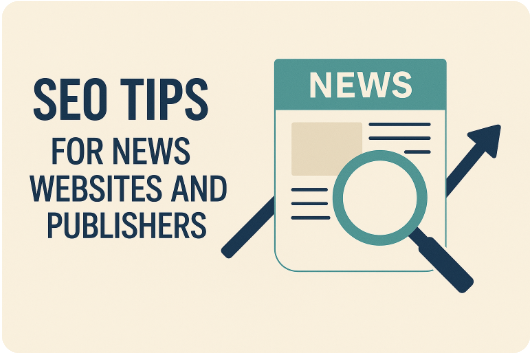In an era where digital news consumption is at an all-time high, the importance of search engine optimization (SEO) for news websites and publishers cannot be overstated. With millions of articles published daily, the competition for visibility is fierce. Optimizing for SEO ensures not just survival, but success in a crowded digital landscape. This opinion piece explores actionable SEO tips tailored to news websites and publishers, offering insights that can make a significant impact on search rankings and audience engagement.
1. Prioritize Speed and Mobile Friendliness
In a world where users demand instant access to information, the speed of your website is crucial. Search engines like Google use page speed as a ranking factor, and news websites are no exception. To improve speed:
- Use lightweight themes and minimize CSS and JavaScript files.
- Implement lazy loading for images and videos.
- Leverage browser caching and content delivery networks (CDNs).
Mobile-friendliness is equally important. Over 60% of internet traffic now comes from mobile devices, making responsive design non-negotiable. Test your website’s mobile usability with tools like Google’s Mobile-Friendly Test and ensure a seamless experience for all users.
2. Master Google News SEO
News websites have a unique opportunity to appear in Google News, a platform dedicated to providing users with timely and relevant news content. To optimize for Google News:
- Use structured data: Implement schema markup to help Google understand your content.
- Submit your website to Google Publisher Center: This increases your chances of being featured in Google News.
- Write clear and accurate headlines: Headlines should be concise, informative, and keyword-rich.
Google News values trustworthiness, so ensure your website’s credibility by maintaining high journalistic standards and including clear author bylines and publication dates.
3. Focus on Fresh and Evergreen Content
Timeliness is the cornerstone of news publishing, but don’t overlook the value of evergreen content. While breaking news attracts immediate attention, evergreen articles like “How-to Guides,” “Explainers,” and “Historical Analyses” drive consistent traffic over time.
- Combine breaking news with related evergreen content to create value for readers.
- Regularly update evergreen content to keep it relevant and improve its ranking potential.
By balancing fresh news and evergreen pieces, you can cater to both immediate and long-term audience needs.
4. Craft Click-Worthy Titles and Meta Descriptions
A compelling headline can make or break your article’s click-through rate (CTR). However, there’s a fine line between click-worthy and clickbait. Focus on:
- Relevance: Ensure the headline reflects the article’s content accurately.
- Keywords: Include primary keywords naturally.
- Emotion: Use action-oriented words to engage readers.
For meta descriptions, keep them under 160 characters, summarize the article’s essence, and include a call-to-action (CTA) when appropriate. Both titles and meta descriptions should entice users to click while staying true to the content.
5. Optimize Images and Videos
Visual content plays a significant role in news articles, enhancing user engagement and improving SEO. To optimize images and videos:
- Use descriptive file names and alt text with relevant keywords.
- Compress images to reduce page load times without compromising quality.
- Host videos on platforms like YouTube or Vimeo and embed them on your site.
- Create transcripts for video content to make it accessible and boost keyword relevance.
Multimedia elements should enrich the user experience and align with your article’s topic to maximize their impact on rankings.
6. Leverage Internal Linking
Internal links guide readers to other relevant articles on your website, increasing session duration and reducing bounce rates. They also help search engines understand the structure of your website. When adding internal links:
- Use descriptive anchor text with keywords.
- Link to both recent and evergreen content.
- Avoid overloading articles with too many links, which can overwhelm readers.
A well-thought-out internal linking strategy strengthens your website’s authority and enhances the user experience.
7. Monitor and Optimize for E-A-T
E-A-T—Expertise, Authoritativeness, and Trustworthiness—is a core principle in Google’s search quality guidelines. For news publishers, building E-A-T involves:
- Publishing content written by qualified and credible authors.
- Including author bios to highlight their expertise.
- Citing reputable sources and linking to authoritative websites.
- Securing your site with HTTPS.
High E-A-T scores boost your credibility in the eyes of both readers and search engines.
8. Harness the Power of Social Media
While social signals aren’t direct ranking factors, they can amplify your content’s reach and drive traffic to your site. Optimize your articles for social sharing by:
- Adding social sharing buttons.
- Crafting engaging snippets for platforms like Twitter and Facebook.
- Using Open Graph tags and Twitter Cards to control how your content appears when shared.
Social media is a powerful tool for increasing visibility and fostering audience engagement.
9. Analyze and Adapt with SEO Tools
Data-driven decision-making is crucial for effective SEO. Tools like Google Analytics, Google Search Console, and SEMrush provide valuable insights into your website’s performance. Use these tools to:
- Track organic traffic and user behavior.
- Identify high-performing keywords and content.
- Monitor backlinks and remove harmful ones.
- Discover technical issues like broken links and crawl errors.
Regularly reviewing analytics ensures you stay ahead of the competition and adapt to changing trends.
10. Stay Updated with SEO Trends
The digital landscape is constantly evolving, and SEO is no exception. News publishers must keep up with:
- Algorithm updates from search engines.
- Emerging technologies like voice search and AI.
- Changing user behaviors and content consumption patterns.
Subscribing to reputable SEO blogs, attending industry webinars, and participating in online forums can help you stay informed and proactive.
Final Thoughts
SEO is not a one-time effort but an ongoing process, especially for news websites and publishers operating in a dynamic and competitive environment. By prioritizing speed, mastering Google News SEO, crafting compelling content, and staying adaptable, news organizations can enhance their visibility, build credibility, and serve their audiences more effectively. In an industry where the race for attention never stops, investing in robust SEO strategies is not just advisable—it’s essential.
Frequently Asked Questions (FAQ):
Q: What are the most important SEO foundations for a news site?
A: Ensure fast, mobile‑friendly pages, clean markup, strong internal linking from home/section pages, and clear bylines, dates, and contact details. Add Article/NewsArticle schema, maintain both a standard XML sitemap and a News sitemap, and avoid blocking critical JS/CSS.
Q: How can I get stories indexed and showing in Google quickly?
A: Publish on stable URLs, link new stories from prominent pages, and keep a fresh News sitemap that updates on publish. Fast servers, clean HTML, and strong site reputation help; Google’s Indexing API doesn’t apply to news content.
Q: Do I still need AMP for Top Stories?
A: No. AMP isn’t required. Focus on Core Web Vitals, good UX, high‑quality images, strong headlines, and authoritative reporting.
Q: Which structured data should publishers use?
A: Use NewsArticle (or Article) plus BreadcrumbList and ImageObject; add VideoObject for video and LiveBlogPosting for live coverage. Use ClaimReview for fact checks and paywall markup with isAccessibleForFree set appropriately.
Q: How should I write headlines and titles for news SEO?
A: Keep them concise, specific, and front‑load key entities (people, places, topics). Avoid clickbait and excessive punctuation; ensure the on‑page H1 and title tag closely match and stay stable after publishing.
Q: How do paywalls impact SEO and Google News?
A: Paywalled content can rank if you follow Google’s subscription/paywall guidelines and add the correct structured data. Provide a visible “Updated” label and preview text, avoid cloaking, and be consistent with metered or freemium models.
Q: Should I update an article or publish a new one for ongoing stories?
A: For evolving coverage, update the main piece with dateModified and an “Updated” note; for major new developments, publish a fresh article and cross‑link. Use LiveBlogPosting schema for rolling/live updates.
Q: What are best practices for images and video in news articles?
A: Use a unique lead image at least 1200px wide and permit max‑image‑preview:large. Optimise filenames/alt text, include VideoObject markup for clips, and ensure media is crawlable (no blocked CDNs).
Q: How can local or niche publishers compete in search?
A: Double down on original reporting, local expertise, and consistent beats. Strengthen E‑E‑A‑T with author bios, editorial policies, corrections pages, and clear contact details.
Q: What is a News sitemap and how should I set it up?
A: It lists articles from the last 48 hours (up to 1,000 URLs). Generate it automatically on publish, submit it in Search Console, and keep your standard XML sitemap for long‑term discovery.
Q: How do I improve visibility in Google News and Discover?
A: Meet content policies, be transparent (bylines, dates, masthead), publish consistently, and use high‑quality, large images. You don’t apply for inclusion; use Publisher Center to manage branding/feeds while focusing on quality and site performance.
Q: What technical issues most often hurt news SEO?
A: Slow pages, intrusive ads, duplicate/parameter URLs, incorrect canonicals, blocked resources, infinite scroll without proper pagination, and inconsistent dates/bylines. Monitor Crawl Stats, Core Web Vitals, and fix 4xx/5xx errors promptly.



